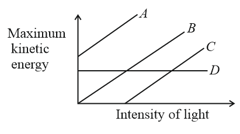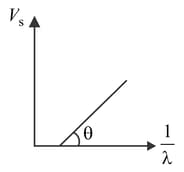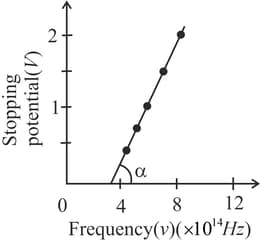For photoelectric effect which of the following statements are true.
I) The kinetic energies of the photoelectrons do not depend on the frequency of light
II) Photoelectric effect will always occur for highly intense light
III) The maximum kinetic energy of photoelectron does not depend upon the intensity of the light
IV) The escaping electron's kinetic energy is larger for larger frequency
Important Questions on Dual Nature of Matter and Radiation
The graph between maximum kinetic energy and intensity of light in photoelectric effect is plotted. Out of the four graphs shown in the figure, the correct graph is

In a photoelectric effect experiment, the graph of stopping potential versus reciprocal of wavelength obtained is shown in the figure. As the intensity of incident radiation is increased :

Electrons are emitted with kinetic energy from a metal plate by an irradiation of light of intensity and frequency Then, which of the following will be true?
In an experimental observation of the photoelectric effect, the stopping potential was plotted against the incident light frequency as shown in the figure below:

If the work function of the metal is given by , the angle is given by
(Here, and are Planck's constant and charge of electron respectively).
( = Planck's constant, = speed of light)
| 0.3 | 2.0 |
| 0.4 | 1.0 |
| 0.5 | 0.4 |
Given that Planck's constant (in units of ) found from such an experiment is :


